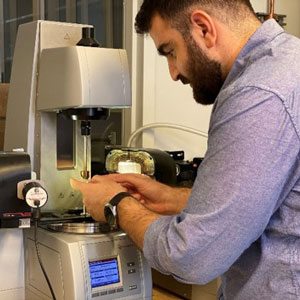Organ transplants save lives, but there are so many people on waiting lists that never get one. Birmingham graduate Kamil Elkhoury (MSc Advanced Chemical Engineering, 2017) is working on creating organs using a technique called bioprinting to address this shortage.
Kamil has recently been recognised by Forbes’ and MIT’s lists of rising stars for the huge potential of his work, which he is developing at New York University Abu Dhabi (NYUAD) campus. Kamil explained how it works: ‘Bioprinting uses the same principles as a 3D printer, which pipes melted plastic into new shapes, building them up layer by layer to become 3D. Instead of melted plastic, we use living cells mixed into a gel, and instead of a plastic gadget, we create biologically functional tissues and, hopefully one day, full organs.’
‘Human tissues and organs are complex, so we need to give each one not just a different shape, but different properties. For example, for heart tissues the construct must conduct electrical signals for synchronized contractions, just like a natural heart.’
‘If we can perfect these techniques, we could one day create patient-specific tissues or organs in a matter of days, reducing the need for long waiting lists and improving patient outcomes.’
Getting started at Birmingham
 Kamil discovered the revolutionary potential of bioprinting at Birmingham. He said: ‘I first heard about bioprinting as part of my Master's studies, learning from Professor Liam Grover and Dr Sophie Cox. Birmingham is one of the few universities which combines teaching in chemical engineering with bioengineering. It is a challenging course, but studying really hard at Birmingham helped shape my work ethic. And working across disciplines really prepared me for my work now, which brings together chemical engineering, biology and mechanical engineering.
Kamil discovered the revolutionary potential of bioprinting at Birmingham. He said: ‘I first heard about bioprinting as part of my Master's studies, learning from Professor Liam Grover and Dr Sophie Cox. Birmingham is one of the few universities which combines teaching in chemical engineering with bioengineering. It is a challenging course, but studying really hard at Birmingham helped shape my work ethic. And working across disciplines really prepared me for my work now, which brings together chemical engineering, biology and mechanical engineering.
‘I loved studying at Birmingham. I lived at Bath Row, just one stop away on the train. Joining the football society made sure I got out of the labs and got some exercise. I also joined the society that supports the work of UNICEF, the United Nations organisation founded to help give more children in need a better quality of life. We ran socials and fundraisers to discuss current issues, have fun and raise money to help improve children’s lives.’
Connecting with our Dubai campus
‘Although I studied at Edgbaston, I live one hour away from the new campus in Dubai now and was curious to see it. Following a discussion at an alumni event, I reached out to Dr Majid Malboubi, and we set up a collaboration between the University of Birmingham Dubai and NYUAD.’
Dr Malboubi said: ‘Our research areas really overlap; we speak the same scientific language. Our Dubai campus is building research capacity and it is important to form collaborations with other institutes. The collaboration with Kamil will allow our students to access critical resources and help us work together to make discoveries more quickly.’
Next steps; perfecting the ingredients
To develop tissues and organs that could be used for transplantation, Kamil is now investigating the right kind of gel to be used while bioprinting. He said: ‘To turn living cells into new tissues and organs, we mix them with gels so they keep their new shape. The gel is intended as a support to cells while they are growing and maturing. Once fully matured, the cells will form their own natural support and the gel will degrade safely in the body. At the moment, I’m investigating how the choice of gels can be more compatible with the cells so they can grow and mature efficiently, and how the gels can help provide the right properties for the relevant part of the body. For example, in a recently published study, to bioprint new menisci for the knees, we used a strong yet flexible gel to withstand the mechanical stresses of daily movement, such as walking and running.’